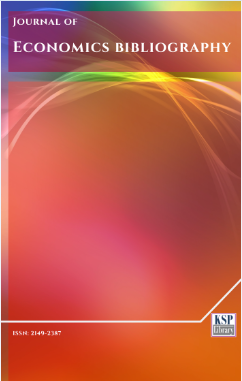Revisiting Determinants of Money Demand Function in Pakistan
Abstract
Abstract. This study investigates the factors such as interest rate, GDP per capita, exchange rate, fiscal deficit, urban and rural population to determine money demand function for Pakistan over the period from 1972-2013. We use ARDL Bound Testing approach in order to test long run relation between money demand and its factors whereas both long and short run coefficients will be found using similar approach. The results show that real interest rate exerts significant and negative effect upon money demand in both long and short run in Pakistan. The results also disclose that exchange rate and rural population are leaving significant but negative effect on the demand for money. These findings are robust to different diagnostic tests..
Keywords. Pakistan, Money Demand, Interest Rate, Per Capita GDP, Fiscal Deficit and Exchange Rate.
JEL. E40, E41, E50.Keywords
References
Abdullah, H., Ali, J., & Matahir, H. (2010). Re-examining the Demand for money in Asean-5 countries. Asian Social Science , 6(7), 146-155. doi. 10.5539/ass.v6n7p146
Abdulkheir, A.Y. (2013). An Analytical Study of the Demand for Money in Saudi Arabia. International Journal of Economics and Finance , 5(4), 31-38. doi. 10.5539/ijef.v5n4p31
Akhtar, M.A. (1974). The demand for money in Pakistan. The Pakistan Development Review, 13(1), 40-54.
AL-Towaijri, H.A., & Al-Qudair, K.H. (2006). The Impact of Government Deficits on Money Demand: Evidence from Saudi Arabia. Arab Journal of Administrative Sciences , 13(2), 1-15.
Anwar, S., & Asghar, N. (2012). Is demand for smoney is stable in pakistan? Pakistan Economic and Social Review , 50(1), 1-22.
Arize, A.C., & Nam, K. (2012). The demand for money in Asia:Some further evidence. International Journal of Economics and Finance , 4(8), 59-71. doi. 10.5539/ijef.v4n8p59
Azim, P., Ahmed, N., Ullah, S., Zaman, B.U., & Zakaria, M. (2010). Demand for Money in Pakistan: an Ardle Approach. Global Journal of Management and Business Research, 10(9), 76-80.
Bahmani-Oskooee, M., & Rehman, H. (2005). Stability of the money demand function in Asian developing countries. Applied Economics, 37(7), 773-792. doi. 10.1080/0003684042000337424
Baumol, W.J. (1952). The Transactions Demand for Cash: An Inventory Theoretic Approach. Quarterly Journal of Economics , 66(4), 545-556. doi. 10.2307/1882104
Bhatta, S. R. (2013). Stability of Money Demand Function in Nepal. Banking Journal , 3(1), 1-27. doi. 10.3126/bj.v3i1.7508
Caporale, G.M., & Gil-Alana, L.A. (2005). Fractional Co-integration and Aggregate Money Demand Functions. The Manchester School, 73(6), 737-753. doi. 10.1111/j.1467-9957.2005.00475.x
Dritsakis, N. (2011). Demand for Money in Hungary: An ARDL Approach. Review of Economics and Finance , 1, 1-16.
Dharmadasa, C., Makoto, A., & Nakanishi,M., (2013). Demand for Money in Sri Lanka: ARDL Approach to Co-integration. 3rd International Conference on Humanities, Geography and Economics (ICHGE'2013). Bali (Indonesia), 143-147.
Faridi, M.Z., & Akhtar, M.H. (2013). An Estimation of Money Demand Function in Pakistan: Bound Testing Approach to Co-integration. Pakistan Journal of Social Sciences, 33(1), 11-24.
Friedman, M. (1956). The Quantity Theory of money: A Restatement. University Chicago Press, 128-138.
Fisher, I. (1911). The Purchasing Power of Money. New York:Macmillan.
Handa, J. (2009). Monetary Economics. New York: Routledge.
International Financial Statistics. (2015). [CD Rom 2015]. International Monetary Fund.
Keynes, J.M. (1936). The General Theory of Employment, Interest, and Money. London and New York:Macmillan.
Khan, A., & Sajjid, M.Z. (2005). The Exchangr Rate and Monetary Dynamics in Pakistan: An Autoregressive Distributed Lag (ARDL) Approach. The Lahore Journal of Economics, 10(2), 87-99.
Khrawish, H.A., Khasawneh, A.Y., & Khrisat, F.A. (2012). The Impact of Budget Deficits on Money Demand in Jordan: Co-integration and Vector error correction Analysis. Journal of Investment Management and Financial Innovations, 9(2), 101-108.
Marshall, A. (1923). Money, Credit and Commerce. Journal of the Royal Statistical Society, 86(3), 430-433.
Mundell, R.A. (1963). Capital Mobility and Stabilization Policy under Fixed and Flexible Exchange Rates. The Canadian Journal of Economics and Political Science, 29(4), 475-485.
Narayan, P.K., Narayan, S., & Mishra, V. (2009). Estimating money demand function for South Asian Countries. Empirical Economics, 36(3), 685-696. doi. 10.1007/s00181-008-0219-9
Ng, S., & Perron, P. (2001). LAG Length Selection and the Construction of Unit Root Tests with Good Size and Power. Econometrica, 69(6), 1519-1554. doi. 10.1111/1468-0262.00256
Okonkwo, O.N., Ajudua, M.I., & Alozie, S.T. (2014). Empirical Analysis of Money Demand Stability in Nigeria. Journal of Economics and Sustainable Development, 5(14), 138-145.
Pakistan Economic Survey. (Various Volumes and Issues). Government of Pakistan, Finance Division, Economic Adviser's Wing, Islamabad.
Pesaran, M.H., Shin, Y., & Smith, R.J. (2001). Testing Approaches to the analysis of level Relationships. Journal of Applied Econometrics, 16(3), 289-326. doi. 10.1002/jae.616
Pigou, A.C. (1917). The Value of Money. The Quarterly Journal of Economics, 32(1), 38-65. doi. 10.2307/1885078
Qayyum, A. (2005). Modelling the demand for money in Pakistan. The Pakistan Development Review, 44(3), 233-252.
Sahadudheen, I. (2011). Demand for Money and Exchange Rate: Evidence for Wealth Effect in India. Undergraduate Economic Review, 8(1), 1-15.
Sarwar, H., Sarwar, M., & Waqas, M. (2013). Stability of Money Demand Function in Pakistan. Economic and Business Review, 15(3), 197-212.
Tang, T.C. (2007). Money demand function for Southeast Asian countries:An empirical view from expenditures components. Journal of Economic Studies, 34(6), 476-496. doi. 10.1108/01443580710830952
Tobin, J. (1956). The Interest Elasticity of the Transactions Demand for Cash. Review of Economics and Statistics, 38(3), 241-247. doi. 10.2307/1925776
Tobin, J. (1958). Liquidity Preference as Behavior Towards Risk. Review of Economic Studies, 25(2), 65-86. doi. 10.2307/2296205
Vamvoukas, G.A. (2010). The relationship between budget deficits and money demand: evidence from a small economy. Applied Economics, 30(3), 375-382. doi. 10.1080/000368498325895
World Development Indicators. (2015). [CD Rom 2015], World Bank, Washington, D.C.
DOI: http://dx.doi.org/10.1453/jeb.v3i4.1132
Refbacks
- There are currently no refbacks.
.......................................................................................................................................................................................................................................................................................................................................
Journal of Economics Bibliography - J. Econ. Bib. - JEB - www.kspjournals.org
ISSN: 2149-2387.
Editor: [email protected] Secretarial: [email protected] Istanbul - Turkey.
Copyright © KSP Library

